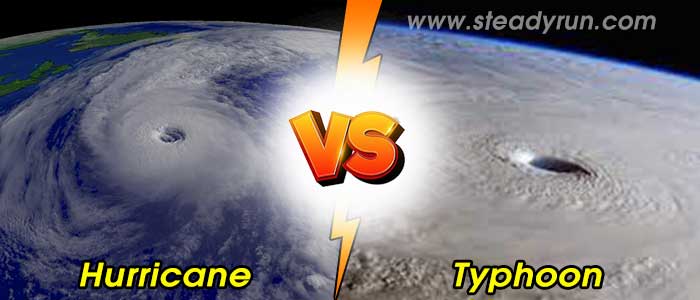How to Use Design Principles to Boost Your YouTube Channel's Appeal

Discover the fascinating differences between hurricanes and typhoons in this comprehensive guide filled with interesting facts and essential knowledge about nature's most destructive weather phenomena.
When devastating storms strike our planet, we often hear terms like "hurricane" and "typhoon" used interchangeably in media reports. But did you know these storms are actually the same weather phenomenon with different names based solely on their location? Understanding the hurricane vs typhoon debate isn't just meteorological trivia—it's crucial knowledge that can help you stay informed about global weather patterns and natural disaster preparedness.
Difference between Hurricane vs Typhoon
- Hurricane is tropical cyclone that affects the Atlantic and northeast Pacific ocean. Typhoon is a tropical cyclone that develops in the northwest Pacific ocean.
- There are about 6 - 10 hurricanes per year. There are about 25 - 30 typhoons per year.
- Occurrence of Hurricane is possibly between June to November month. Possibility of Typhoon is from May to October.

What Are Hurricanes and Typhoons?
The fundamental truth is that hurricanes and typhoons are identical meteorological phenomena—both are tropical cyclones with sustained winds exceeding 74 mph (119 km/h). The only distinction lies in geography, making this one of nature's most interesting location-based naming conventions.
The Technical Definition
Tropical cyclones are massive rotating storm systems that form over warm ocean waters. They're characterized by:
- Low atmospheric pressure centers
- Spiral rain bands
- Strong winds rotating around the eye
- Formation over water temperatures above 80°F (26.5°C)
Geographic Naming Conventions
The most critical hurricane vs typhoon difference lies in where these storms occur:
Hurricanes: Atlantic and Eastern Pacific
Hurricanes form in:
- Atlantic Ocean (including Caribbean Sea and Gulf of Mexico)
- Eastern Pacific Ocean (off the coast of Mexico and Central America)
Fun Fact: The word "hurricane" comes from the Taino Native American word "hurakán," which Spanish colonizers adopted.
Typhoons: Western Pacific
Typhoons develop in:
- Western Pacific Ocean (particularly affecting East and Southeast Asia)
- South China Sea
- Philippine Sea
Interesting Note: The term "typhoon" likely originated from the Chinese word "tai fung," meaning "great wind."
Cyclones: Indian Ocean and South Pacific
In other regions, these same storms are simply called cyclones:
- Bay of Bengal and Arabian Sea
- South Pacific Ocean
Regional Characteristics and Differences
Wind Speed Variations
While both hurricanes and typhoons share the same minimum wind speed threshold, typhoons often reach higher intensities. Studies show that typhoons in the Western Pacific tend to be more powerful due to:
- Warmer sea surface temperatures
- Larger areas of warm water
- Favorable atmospheric conditions
The most intense tropical cyclone ever recorded was Typhoon Tip in 1979, which had wind speeds of 190 mph (305 km/h)—far exceeding any Atlantic hurricane on record.
Seasonal Patterns
- Hurricane season: June 1 to November 30 (Atlantic)
- Typhoon season: May to October (with peak activity in August and September)
Formation and Environmental Factors
Both storms require identical formation conditions:
- Warm ocean water (80°F+)
- Low wind shear
- Moisture in mid-level atmosphere
- Distance from the equator (typically 5° latitude or more)
However, the Western Pacific produces more storms annually—averaging 26 named storms compared to the Atlantic's 12-14.
Interesting Facts and Records
Size Comparisons
- Hurricanes: Typically 300-500 miles wide
- Typhoons: Can span 1,000+ miles (Typhoon Tip covered 1,380 miles!)
Economic Impact
- Hurricanes: Cost the United States approximately $54 billion annually
- Typhoons: Cause over $10 billion in damages yearly across Asia
Historical Significance
- The Galveston Hurricane of 1900 (a Category 4 hurricane) remains the deadliest natural disaster in U.S. history
- Typhoon Haiyan (2013) was one of the strongest storms ever recorded, devastating the Philippines
Naming Systems and Classification
Both hurricanes and typhoons follow predetermined naming lists:
- Hurricanes: Use rotating alphabetical lists maintained by the World Meteorological Organization
- Typhoons: Named by the ESCAP/WMO Typhoon Committee using names contributed by member countries
If storms cause exceptional damage, their names are retired and replaced.
Climate Change Impact
Recent research reveals concerning trends:
- Hurricane intensity is increasing due to warmer Atlantic waters
- Typhoon frequency in the Western Pacific shows slight increases
- Rainfall rates are intensifying for both storm types due to increased atmospheric moisture
Tracking and Prediction
Modern meteorology uses identical tracking methods:
- Satellite imagery
- Aircraft reconnaissance (primarily for Atlantic hurricanes)
- Computer modeling
- Weather buoys and radar
Safety and Preparedness
Whether facing a hurricane or typhoon, preparation remains crucial:
- Evacuation planning
- Emergency supply kits
- Property protection measures
- Communication plans
Pro Tip: The Northern Hemisphere's Coriolis effect causes hurricanes and typhoons to rotate counterclockwise—a fascinating physics phenomenon!
Global Perspective
Understanding that hurricanes, typhoons, and cyclones are essentially the same storms highlights our interconnected world. When a massive storm hits the Philippines as a typhoon, or devastates Florida as a hurricane, we're witnessing the same powerful natural force—just in different locations.
Conclusion: Beyond the Names
The hurricane vs typhoon distinction ultimately reminds us that geography shapes our understanding of natural phenomena. These storms represent some of Earth's most powerful displays of atmospheric energy, regardless of their regional names. As climate patterns evolve, understanding these systems becomes increasingly important for global preparedness and scientific research.
Whether you're planning a trip to hurricane-prone Caribbean islands or typhoon-affected areas of Japan, knowing the science behind these storms helps you appreciate both their awesome power and the sophisticated systems we've developed to track and prepare for them.
The next time you hear weather reports mentioning these storms, remember: it's not what they're called that matters—it's understanding the incredible forces of nature they represent and staying informed about their potential impact on our interconnected world.
Tags:
Difference between Typhoon vs Hurricane
Hurricane vs Typhoon
Differences between Typhoon vs Hurricane
Image Credits: Freepik








